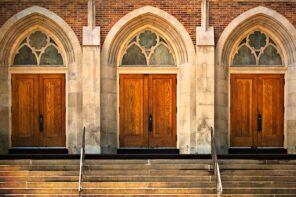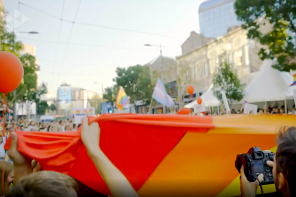The surprisingly conciliatory tone regarding gay Catholics in the working document for the family synod released yesterday is being described by some as an “earthquake” and “revolutionary.” But it’s not so much the content that’s groundbreaking—it’s the fact that the church is admitting that yes, on hot-button issues it can evolve, something it has denied for the past 35 years.
Let’s face it, in admitting that “[h]omosexuals have gifts and qualities to offer the Christian community” and that same-sex unions offer “mutual aid to the point of sacrifice” that “constitutes a precious support in the life of the partners,” the leaders of the Catholic Church have more or less caught up to where the culture was in about 1997, when Ellen DeGeneres became the first openly gay character in a TV show and the news of her coming out was big enough to warrant the cover of Time magazine. The following year, “Will & Grace” debuted and mainstream America began its rapid evolution in its acceptance of both homosexuality and eventually same-sex marriage.
And this truly is a case where change at the top comes long after the grassroots. Many congregations have welcomed LGBT Catholics for years. Gay Catholics also teach openly at many Catholic schools; it’s only when they marry that their sexual orientation becomes a problem. And Catholics have been at the forefront of acceptance of same-sex partnerships since the early 2000s; by 2010, 62% of Catholics considered gay and lesbian relations “morally acceptable.”
The new language is nonetheless a welcome change for LGBT Catholics, who obviously weren’t thrilled at being referred to as “intrinsically disordered,” though that does remain the official doctrine of the church. “That positive language is more affirming and will give many people hope. It is much more respectful, and offers a sense of welcome that LGBT people have been seeking for decades,” said Marianne Duddy-Burke of DignityUSA.
It’s also somewhat miraculous that there was enough agreement amongst the bishops on the more welcoming language, despite the presence of obvious holdouts like Cardinal Raymond Burke. In response to the story of a long-married Catholic couple who had reportedly moved the bishops with their story about friends who welcomed their gay son and his partner home for Christmas, Burke told LifeSiteNews that children shouldn’t be exposed to “profoundly disordered” relationships:
We wouldn’t, if it were another kind of relationship — something that was profoundly disordered and harmful — we wouldn’t expose our children to that relationship, to the direct experience of it. And neither should we do it in the context of a family member who not only suffers from same-sex attraction, but who has chosen to live out that attraction, to act upon it, committing acts which are always and everywhere wrong, evil.
By contrast to the church’s more progressive tone on LGBT issues, and its candid acknowledgement that cohabitation and civil unions are here to stay and shouldn’t necessarily disqualify Catholics from participation in church life, it remains firmly stuck in the past on contraception.
The document reaffirms the importance of the teaching of Humanae Vitae that “[b]eing open to life is an intrinsic requirement of married love.” And while it acknowledges the importance of “a realistic language that is able to start from listening to people,” it quickly falls back on the old formulation that Catholics just need “appropriate teaching regarding natural methods” to jump on the natural family planning bandwagon.
Despite Pope Francis’ admonishment to the bishops to speak openly at the synod, the outcome regarding contraception was a foregone conclusion. Many of the couples invited to address the bishops were advocates of natural family planning—just like in 1964, during the Papal Birth Control Commission. The difference is, in 1964, the Catholic couples were light years ahead of the bishops in their attitudes about contraception. Altough they had been selected because they were members of conservative family organizations, they told the bishops that natural family planning didn’t work and put extraordinary strain on marriages.
This time, however, the couples told the bishops exactly what they wanted to hear: that natural family planning was a wonderful thing and that Catholics didn’t really understand the beauty of how obsessively charting a woman’s monthly cycle could bring couples closer together.
This isn’t surprising. As Thomas Reese noted in the National Catholic Reporter, most of the lay auditors to the synod were married Catholic couples who were “employees of the Catholic church or heads of Catholic organizations, including natural family planning organizations” and weren’t “representative of Catholics at large.” The wife in the couple who testified to the bishops about the beauty of NFP is on the U.S. Bishops’ Natural Family Planning Advisory Board.
Where were the couples who talked about the extraordinary juggling act that families face today trying to manage even two children while working and maintaining a home and what an additional unplanned pregnancy might mean to them? Where was the woman talking about the delicate dance of fertility management for someone whose window for having a family falls sometime between when the last grad school loan is paid off and the first gray hairs appear?
Even as they take tentative steps to welcome gay Catholics, the bishops retain the old formulation that women who want to plan their families with a high degree of certainty are doing something fundamentally illicit. When it comes to women and sex, they hear only what they want to hear.




